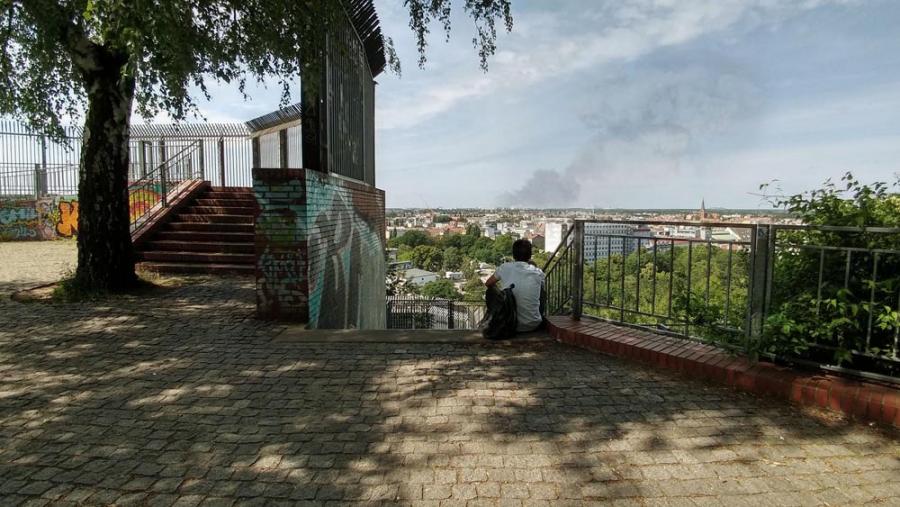HOMESICK / Sharon Paz
Sat, 9 Sep 2017 19:00at uqbar
HOMESICK / Sharon Paz
In her exhibition "Homesick," artist Sharon Paz presents a series of new video works that she has developed for the show at uqbar project space in Berlin-Wedding. In her work, the artist has dealt with the subject of home and migration for several years. She is particularly interested in the recurring patterns of movement between cultures and spaces.
"Homesick" puts the war-torn story of the district in relation to the current situation in the Mediterranean and shows how stories of flight and expulsion, reconstruction and new beginnings recur and interfere.
Sharon Paz (1969, Israel) lives and works in Berlin. She exhibited a.o. in Museum Weserburg, Bremen, Germany, Smack Mellon, New York, USA, the Herzlyia Museum of Art and the Petach-Tikvam Museum of Art, Israel. Her video works are part of the collection of the Neuer Berliner Kunstverein (Video-Forum) and The Israel Museum, Jerusalem.
The project is supported by the Bezirkskulturfonds Mitte, Berlin.
At the center of the exhibition, the artist places a new video work, inspired by the short story The Kitchen Clock by the German writer and playwright Wolfgang Borchert, who is considered part of the so-called Trümmerliteratur (rubble literature) of post-war Germany. The specific short story deals with a young man who lost his home and his parents during a bomb attack. He remembers the care of his mother by means of a remaining kitchen clock and understands the lost family life as a paradise state. Still today, the short story stands for situations in which people lose everything, have to start from scratch and rebuild their lives.
The video was shot at Volkspark Humboldthain in Berlin Mitte, which is one of the oldest public parks in Berlin, built in 1869. In the years 1941/1942, a complex high bunker with two flaked towers, heavily contested towards the end of the Second World War, was errected. After World War II, the bunker and towers were blasted, covered with rubble into an artificial mountain, the so-called Humboldthöhe. and integrated into a new park. Today, the park is considered a recreation area, the upper top plate of the former tower serves as an official vantage point, and a part of the bunker system can be visited again.
Homesick puts the war-torn story of the district in relation to the current situation in the Mediterranean and shows how stories of flight and expulsion, reconstruction and new beginnings recur and interfere.
----
Im Zentrum der Ausstellung steht eine neue Videoarbeit, die von der Kurzgeschichte Die Küchenuhr des deutschen Schriftsteller und Dramatikers Wolfgang Borchert inspiriert ist. Borchert, dessen Werk Teil der sogenannten Trümmerliteratur des Nachkriegsdeutschlands ist, erzählt darin von einem jungen Mann, der bei einem Bombenangriff sein Heim und seine Eltern verloren hat. Mittels einer verbliebenen Küchenuhr erinnert er sich an die Fürsorge seiner Mutter und begreift das verlorene Familienleben als paradiesischen Zustand. Die Kurzgeschichte steht auch heute noch für Situationen, in denen Menschen alles verlieren, von vorne anfangen und ihr Leben neu aufbauen müssen.
Als Drehort diente der Volkspark Humboldthain in Berlin-Wedding, der 1869 angelegt wurde und einer der ältesten öffentlichen Parkanlagen in Berlin ist. In den Jahren 1941/1942 wurden im Park zwei gegen Ende des Zweiten Weltkriegs schwer umkämpfte, verbunkerte Flaktürme mit Hochbunker errichtet. Nach dem 2. Weltkrieg wurden die Türme samt Bunkern gesprengt, mit Schutt bedeckt und zu einem künstlichem Berg, der sogenannten Humboldthöhe aufgeschüttet. Anschließend wurde der Trümmerberg bepflanzt und in den neuangelegten Park integriert. Heute ist der Park ein Erholungsort, die obere Deckplatte des ehemaligen Flakturms dient als offizieller Aussichtspunkt und ein Teil der Bunkeranlage ist wieder zu besichtigen.
Homesick setzt die von Krieg geprägte Geschichte des Bezirks in Verbindung zur aktuellen Situation im Mittelmeerraum und verdeutlicht, wie sich Geschichten von Flucht und Vertreibung, Wiederaufbau und Neuanfang wiederholen, überlagern und miteinander in Beziehung treten.
